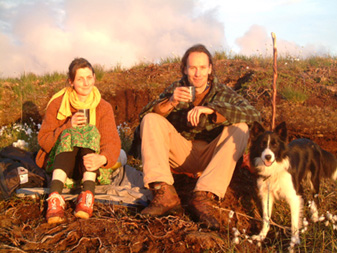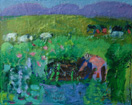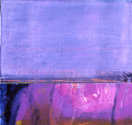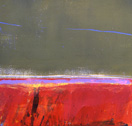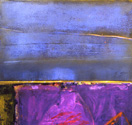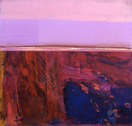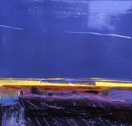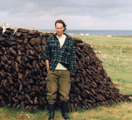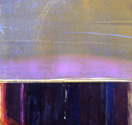Anne Campbell and her
paintings
|
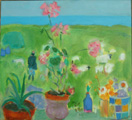
Geranium
|
Anne
I work in oils and mixed media, and also in screenprint, and
screenprint and oils. Some of my work can be seen in the Finsbay
Gallery, Isle of Harris.
I work from anything that catches my eye - the changing colours of the
landscape, patterns of crofts, moor, machair and and shoreline, birds,
animals or people passing by. All my work begins with sketches done
outdoors in the landscape, either here in Lewis or on travels abroad. I
spent a month in India last winter, and have been working on a series
of paintings of Indian gardens (or was, before my time got taken with
fighting windfarms).
|
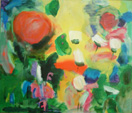
July machair
|
I
have
also
recently
been working on paintings of details of flowers and
vegetation, painted sitting outside - ragged robin, eyebright,
lousewort, sundew, broad bean flowers, sphagnum moss, etc.I like to go
out with several sketchbooks, pencils, charcoal, watercolours and oil
pastels, and do a series of quick drawings and paintings of the
landscape/animals/birds/flowers from one spot, then in the studio work
on several canvases of a subject, not working from just one sketchbook
image but taking elements from several different sketches, trying to
capture the feeling of a certain place or time. |
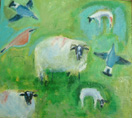
Early Wheatears,
|
We sell our work locally and Jon is currently doing an
Arts Residency at Timespan Arts and Heritage Centre in Sutherland. We
run a croft, keeping sheep and poultry, growing our own vegetables and
soft fruit, and cutting peat for fuel.
We are beginning a project "Lost Names of Bragar" in which we intend to
document place names from the local moorland which have never been
recorded on a any map, and create an artwork for each. The moorland has
been heavily used throughout history, and each feature, however small,
is named. Many of these names are now being forgotten, and the current
windfarm proposals threaten to destroy the physical features of the
landscape as well. |
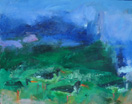
Oystercatchers
|
The
villages
of
the
north of Lewis are all situated on the coast. The
island is treeless and its northern interior is a vast unspoilt
moorland, one of the largest intact areas of blanket bog remaining in
the world. The island is characterised by expansive views of sea nd
sky, and feeling of openness. The area is extremely rich
culturally; it is heartland of the Gaelic language and of a traditional
crofting way of life. The edges of the moorland are used for
small-scale domestic peat-cutting for fuel, and its interior is
scattered with sheilings, small stone huts where people (mainly women
and children) lived in the summer months while grazing their cattle in
the islands interior. This transhumance has now died out, although
sheep are still grazed on the moorland and many people (ourselves
included) still use their family sheilings for leisure. There also
hundreds of archaeological sites on the moorland. |
